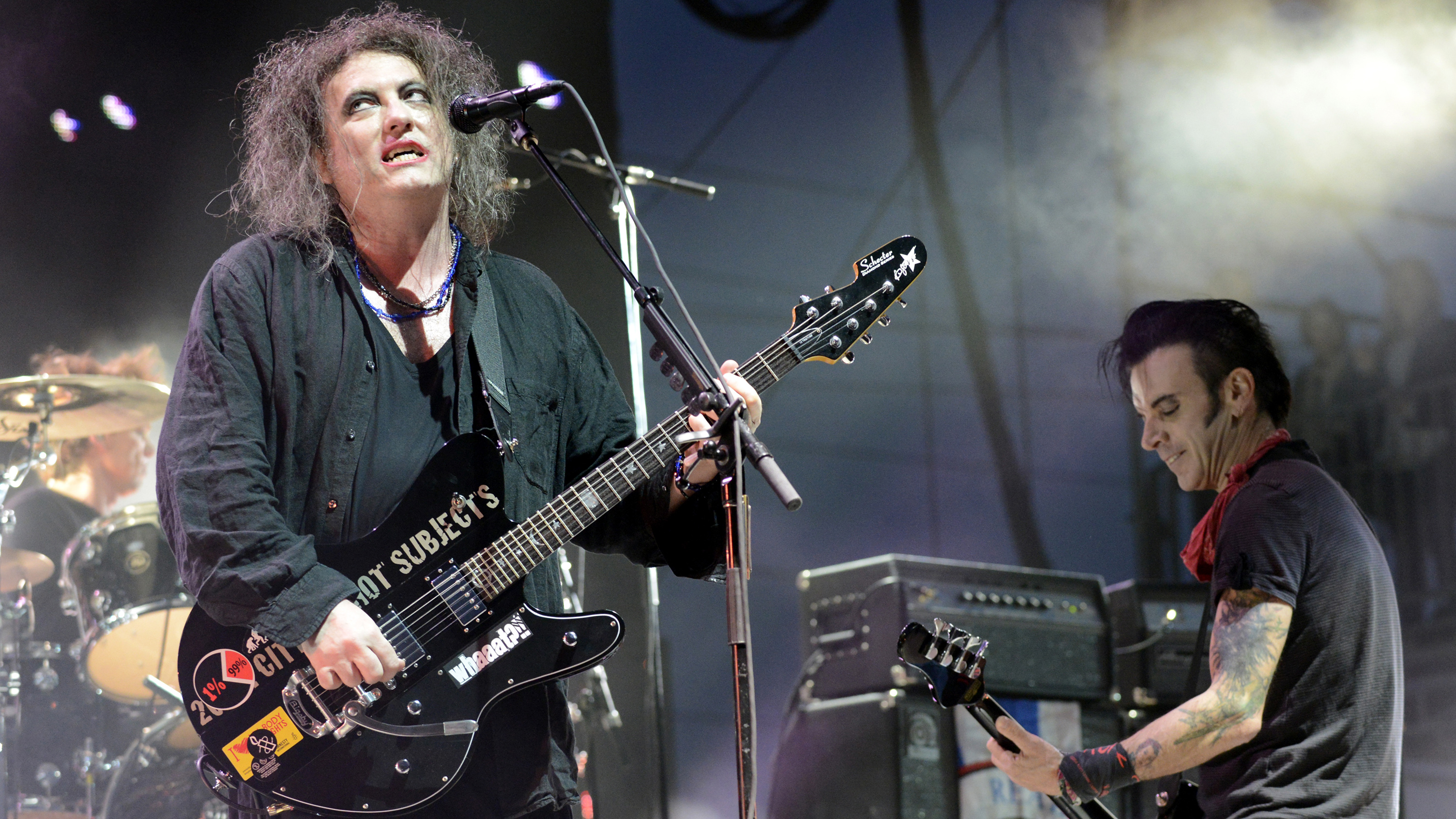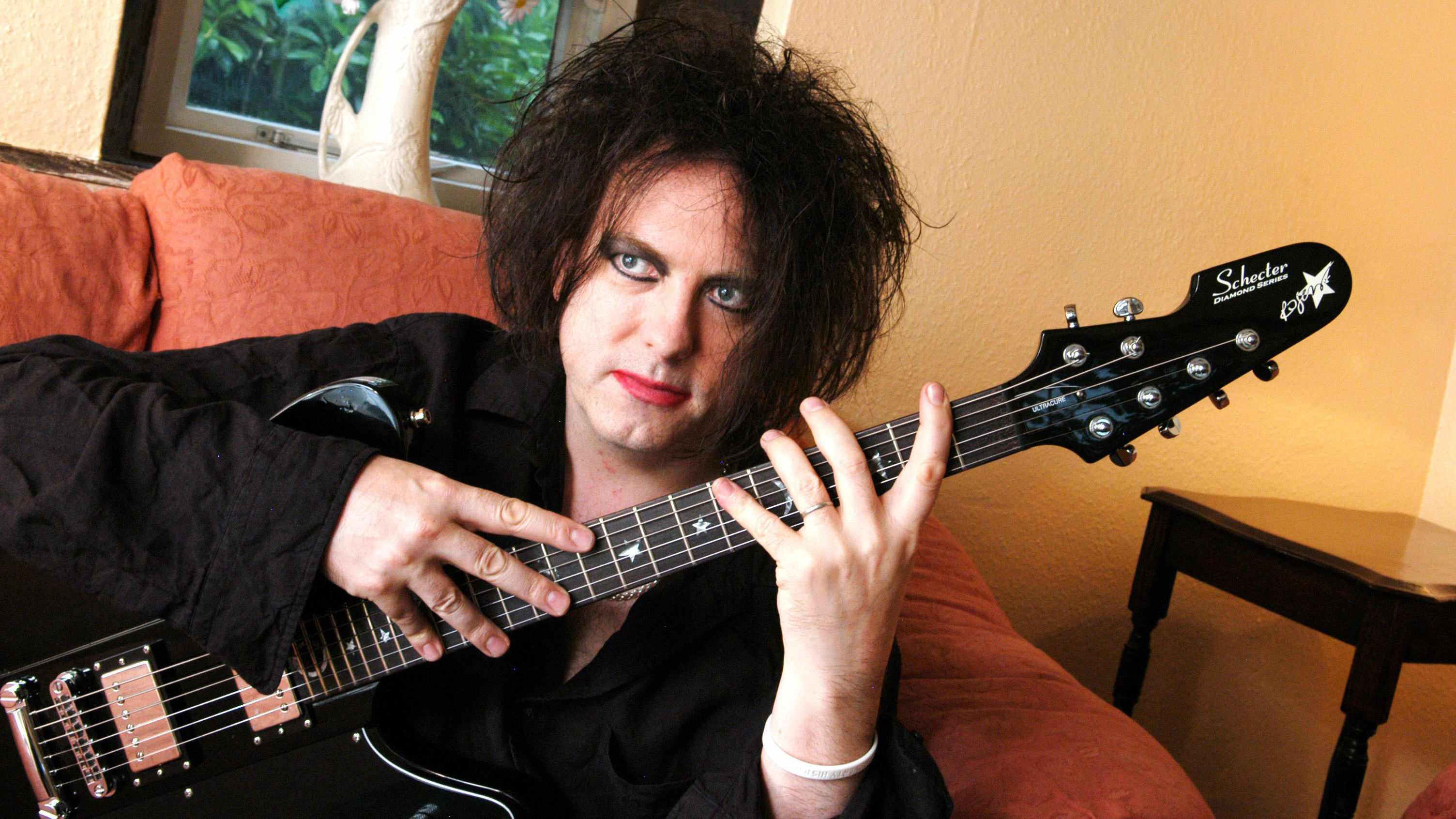5 songs guitarists need to hear by… The Cure
Best of 2022: Show me how you do that trick…

Join us for our traditional look back at the stories and features that hit the spot in 2022
Best of 2022: It’s hard to pin The Cure down in many ways. They have somehow straddled the mainstream and alternative scenes since their genesis, helped no end by Robert Smith’s uncanny ear for a poppy hook.
Given their chart and popular success, though, they’ve never lost their countercultural kudos. So what’s the secret? Smith, undoubtedly, has a great ear for melody, and has developed the idea of the one-string riff perhaps further than most artists would ever dare.
When the Cure first walked into a recording studio they had… well… let’s say limited resources. This is not just a comment on their finances, but also a reflection of the technology readily available at the time. Smith started his career with a Woolworths guitar, before graduating to a Fender Jazzmaster, and as far as effects went, option paralysis was never going to be an issue. Chorus, delay, reverb and maybe a flanger was about all that you could easily find in guitar stores at the time. That, it turned out, wasn’t going to be an issue.
They walked out of those early sessions with the controversial (to those that didn’t properly listen to it) Killing an Arab, which featured on their debut album Three Imaginary Boys under their arms. Although even Smith somewhat decries that album as being rather too lightweight for his tastes, it set the foundations for a new movement. It would go on to form the defining sound of goth-rock in popular music.
By halfway through the 1980s, they had mostly shed their goth tonality, just as the genre was hitting its stride. Smith, though, was getting to the sound he was always chasing, melodic, gloomy, dark and evocative. This was aided by intelligent, sparse arrangements that exude atmosphere, aided by on-point application of reverb. All of this was pulled off despite being a pretty lean lineup of bass, guitar, drums, keys and vocals.
It’s an important note to point out that the Cure are not considered a traditional 'guitar' band (try not to scream 'duh' too loud). A valuable lesson when considering their music is to think of the guitar not just as a riff machine, but as a textural, melodic device as well.
Get the MusicRadar Newsletter
Want all the hottest music and gear news, reviews, deals, features and more, direct to your inbox? Sign up here.
That’s not to say that The Cure are at a loss for riffage; Never Enough is pure '90s guitar-band goodness, replete with a blinding solo straight from the Neil Young playbook. But more on that later. Their seminal Disintegration – song not album – exploits the six string in a form much emulated by their post-punk peers. The inventive contributions of guitarist Porl Thompson proving the perfect foil to Smith, as he did through much of his two tenures with the band.
Smith is often heralded as an underrated guitarist by those in the know, and this certainly rings true. Perhaps the synth textures are a distraction, or his striking image, or status as a posterboy for existential angst, but he’s undoubtedly a tonal expeditionary and guitarist first. Although never one to showboat, Smith’s chops as a guitarist and, ahem, hook-smith are beyond question, and there aren’t many players that can’t benefit from learning from his approach to melody, experimentation and overall service to the song.

Despite being a musical expeditionary, Smith’s rig has always been surprisingly modest, eschewing flashy “boutique” instruments, amps and effects. Instead, the Cure rig consists mainly of off-the-shelf equipment that’s accessible even to us mere mortals. If BOSS made it, Smith has probably used it at some point. Similarly, Roland has featured heavily in his gear history, including the legendary Roland JC-120 Jazz Chorus and multiple Cube 80s for live, with a recent move to Line 6 Spider series. Hardly out of reach, I’m sure you’ll agree.
The mantra of this lesson is that simplicity can be a limiting factor, but one that can inspire some genuinely creative sonic choices. Let’s dive in and start exploring.
1. Just Like Heaven - Kiss Me, Kiss Me, Kiss Me (1987)
If you were going to play someone ONE song to sum up the Cure, this would surely be a contender. OK, maybe Friday I’m In Love is a contender, but anyway. This is one of the defining moments of the band’s career. Robert Smith’s tone and technique have gone on to inspire a diverse plethora of artists over the years. Sift through your music library of choice and you’re sure to find evidence of their inspiration everywhere. One particular example can be found on the Gaslight Anthem’s Old White Lincoln, which although managing to sound more loving homage than outright appropriation, has an awful lot in common with the Cure’s masterpiece.
The track itself is a dreamlike counterpoint to the angsty vocal melody and often painful lyric, whilst the pre-chorus builds a minor tension and rises to a yearning but hopeful major lift. The electric rhythm part is playing mostly third intervals, with the acoustic playing full chords. The synths are restricted to single note lines, which allow the chorus-coloured, simple and iconic lead lines to sing, and provide the emotional backbone to the track. When recently performed live, the guitar is infused with a tad more drive than the studio performance, which lends an extra edge, but even so the elegant simplicity of the melodic line is a lesson for us all. Oh yeah…and there’s only five chords.
2. Never Enough – Mixed Up (1990)
The band had proved themselves as stalwarts of the charts by this point, and had established themselves as worldwide stars. Unlike most of the Cure's output at this time, it was entirely guitar oriented, with none of the usual synth arrangements that had, until now, become something of a signature. The influences here are totally of their time, drawing in musical cues from shoegaze and 'baggy' styles coming out of the Madchester scene, but never losing a distinct Cure-ness.
The absence of synthesisers on the track only further proves Robert Smith’s ability to conjure texture, melody and plain old feeling from a deliberately limited palate. In terms of complexity, this does harken back to the early days of Three Imaginary Boys, but through the lens of a few road miles. Judicious use of some dirt around the edges of the guitars fills in the audio spaces usually occupied by keys, which is an idea worth exploring especially if you’re a player with a small lineup.
3. Killing an Arab - Three Imaginary Boys (1979)
Proof that major locrian scale isn’t a dirty term, nor anything to be scared of. Ok, that might not be totally accurate, but it’s certainly got an Arabic influence running through its veins. We’re not here to discuss its often confused subject matter, but it’s worth touching on. It’s a reference to a scene from Alber Camus’ L’Etranger. Right, with that out of the way…
Every element of the instrumentation, lyrics and delivery is painting a picture, and a valuable lesson in taking a step back and seeing a song as more than just the sum of its parts. It could so easily have wavered into pastiche, but the near emptiness of the production is genuinely evocative of its subject matter. Turning Japanese this ain’t. If you’re a composer or writer hoping to paint pictures there are some serious depths to explore here. This stands alongside the sonic pictures painted by Ennio Moricone. That guitar is thin and deadly, and is almost a piece of sound design.
4. Pictures of You - Disintegration (1990)
To exclude anything from 1990’s Disintegration would be…just…wrong. To call it a defining moment would be an understatement. As a piece of pop writing, it’s pretty untouchable, and as a piece of guitar music it’s criminally underrated. You could swear that there are synths all over this, but the reality is that with a peerlessly tasteful dusting of reverb, delay and modulation the listener is presented with a lush soundscape unparalleled in popular guitar music.
This is not a deep dive into The Cure’s entire catalogue, but if you were to attempt to exemplify Smith’s approach to guitar, effects and composition, you’d be hard pressed to get past Pictures. The effects here are nothing particularly special (we talked about that earlier), but incredibly tastefully layered with a delicacy and intelligence that are genuinely something to aspire to.
Despite moving away from what became a time-specific ;goth-rock' sound, which eventually became a cliche, The Cure still retain that emotional sincerity, creativity and musical authenticity that keep them relevant as a voice in the popular landscape. Alongside that, a continued exploration of sounds and melody have placed Smith particularly firmly in the pantheon of undersung guitar legends.
5. Boys Don’t Cry - Three Imaginary Boys (1979)
There’s a clear lineage on display here; from garage rock, punk, through new wave and arriving at post-punk to define the sound of a musical movement. You can hear the DNA of the Bobby Fuller Four (filtered through the Clash maybe) with the pronounced descent at the end of the refrain line.
There are echoes of Buddy Holly era minimalism and rawness, making the best of a sparse arrangement. There's a hunger here and a punky sensibility, despite sitting firmly in the “post-punk” camp. As we’ve discussed, Smith himself feels the album is undercooked, but there’s a sense of urgency that runs through every track, presumably influenced by the fact that it was recorded in under a week.
There’s less going on here than your brain makes you think. It’s a masterclass in pared-back simplicity. Perhaps it was a product of necessity, but it’s living proof that resources need not be a boundary to greatness. Even the riff itself is lean and mean, but it’s absolutely maximised in the arrangement.
5 songs guitarists need to hear by… Nirvana
“I’m beyond excited to introduce the next evolution of the MT15”: PRS announces refresh of tube amp lineup with the all-new Archon Classic and a high-gain power-up for the Mark Tremonti lunchbox head
“These guitars travel around the world and they need to be road ready”: Jackson gives Misha Mansoor’s Juggernaut a new lick of paint, an ebony fingerboard and upgrades to stainless steel frets in signature model refresh
![PRS Archon Classic and Mark Tremonti MT 15 v2: the newly redesigned tube amps offer a host of new features and tones, with the Alter Bridge guitarist's new lunchbox head [right] featuring the Overdrive channel from his MT 100 head, and there's a half-power switch, too.](https://cdn.mos.cms.futurecdn.net/FD37q5pRLCQDhCpT8y94Zi.jpg)








